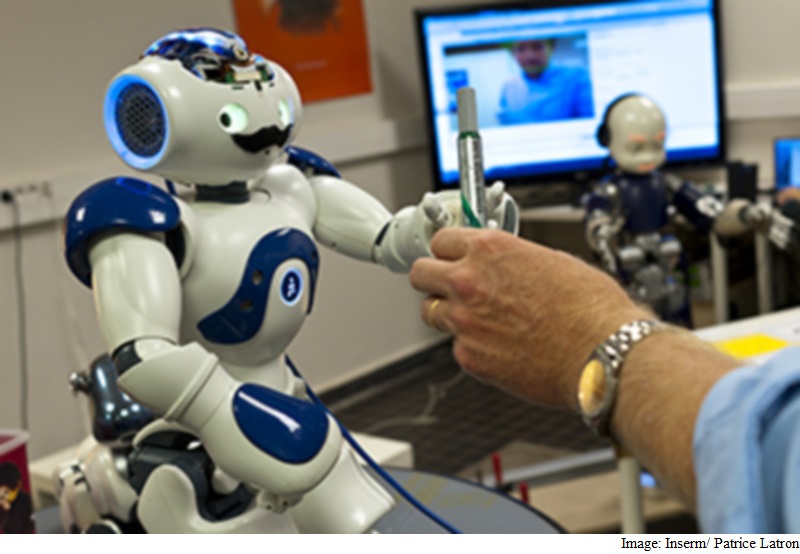- Home
- Science
- Science News
- Humanoid Robot to Liaise Between International Space Station Crews
Humanoid Robot to Liaise Between International Space Station Crews

In order for a robot to understand cooperative behaviour, researchers developed a system whereby a human agent can teach their new "Nao" robot new actions through physical demonstration, visual imitation or voice command.
These individual actions are then combined into procedures and stored in the robot's autobiographical memory developed by researchers, thus enabling the robot to reproduce them for other human agents if needed.
"This technological progress could notably be used for operations on the orbiting laboratory," said senior researcher Peter Ford Dominey from the Institut cellule souche et cerveau (Inserm/Université Claude Bernard Lyon 1).
Researchers set up this autobiographical memory system to meet the challenge of cooperation between humans and robots, with the humanoid "Robonaut 2" which is now permanently flying aboard the ISS.
Autobiographical memory includes events that were personally experienced, along with their context.
It makes it possible to date and locate memories, and to determine who was present during the event.
With human beings, autobiographical memory helps build an individual's personal history.
The transmission of information on board is essential since crews change every six months.
Researchers are now hoping to test their "Nao" robot in the real conditions of space operations with zero gravity.
They would also like to develop another area of application, assisting the elderly, with the robot this time playing the role of a personal memory aid.
"Robonaut 2" is a humanoid robot resulting from the Robonaut programme, a close collaboration between Nasa and the US Defense Advanced Research Projects Agency (DARPA).
A unit was delivered to the ISS in February 2011 to control the robot's operation in weightlessness.
It was designed to assist the work of astronauts in complicated situations, especially during extra-vehicular outings.
The new results were presented at the international symposium on robot and human interactive communication in Kobe, Japan, recently.
For the latest tech news and reviews, follow Gadgets 360 on X, Facebook, WhatsApp, Threads and Google News. For the latest videos on gadgets and tech, subscribe to our YouTube channel. If you want to know everything about top influencers, follow our in-house Who'sThat360 on Instagram and YouTube.
Related Stories
- Samsung Galaxy Unpacked 2025
- ChatGPT
- Redmi Note 14 Pro+
- iPhone 16
- Apple Vision Pro
- Oneplus 12
- OnePlus Nord CE 3 Lite 5G
- iPhone 13
- Xiaomi 14 Pro
- Oppo Find N3
- Tecno Spark Go (2023)
- Realme V30
- Best Phones Under 25000
- Samsung Galaxy S24 Series
- Cryptocurrency
- iQoo 12
- Samsung Galaxy S24 Ultra
- Giottus
- Samsung Galaxy Z Flip 5
- Apple 'Scary Fast'
- Housefull 5
- GoPro Hero 12 Black Review
- Invincible Season 2
- JioGlass
- HD Ready TV
- Laptop Under 50000
- Smartwatch Under 10000
- Latest Mobile Phones
- Compare Phones
- Moto G15 Power
- Moto G15
- Realme 14x 5G
- Poco M7 Pro 5G
- Poco C75 5G
- Vivo Y300 (China)
- HMD Arc
- Lava Blaze Duo 5G
- Asus Zenbook S 14
- MacBook Pro 16-inch (M4 Max, 2024)
- Honor Pad V9
- Tecno Megapad 11
- Redmi Watch 5
- Huawei Watch Ultimate Design
- Sony 65 Inches Ultra HD (4K) LED Smart TV (KD-65X74L)
- TCL 55 Inches Ultra HD (4K) LED Smart TV (55C61B)
- Sony PlayStation 5 Pro
- Sony PlayStation 5 Slim Digital Edition
- Blue Star 1.5 Ton 3 Star Inverter Split AC (IC318DNUHC)
- Blue Star 1.5 Ton 3 Star Inverter Split AC (IA318VKU)

















